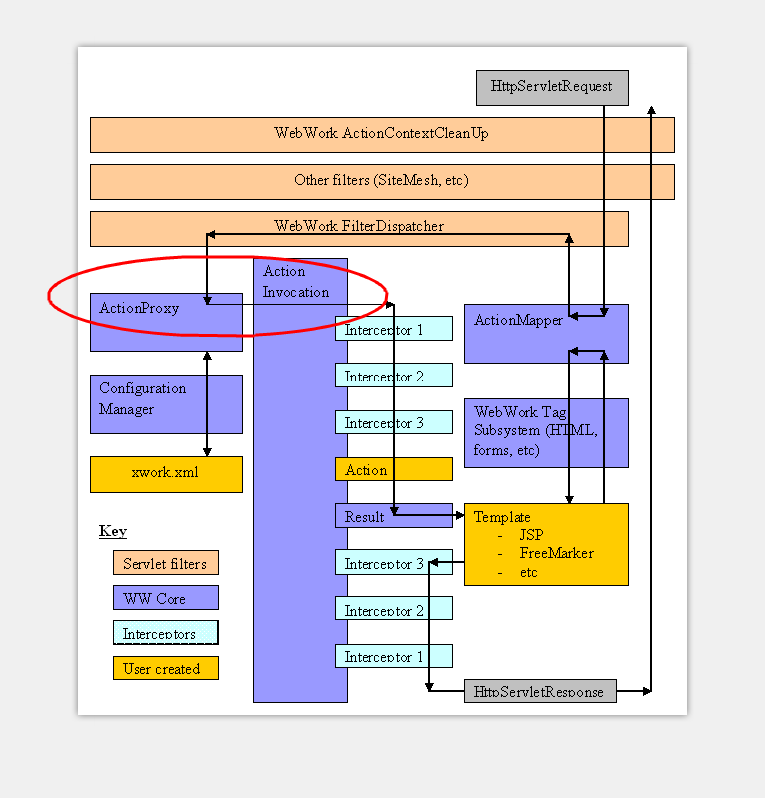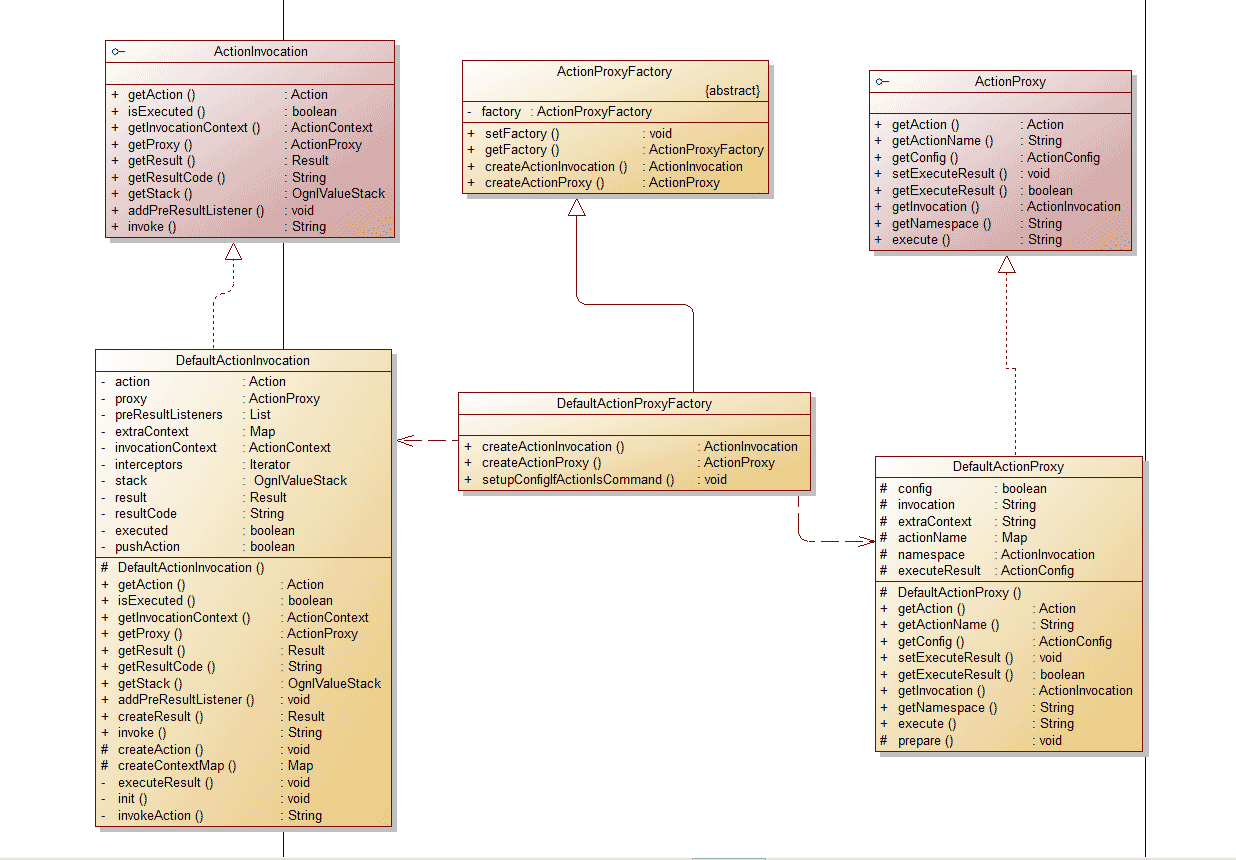详解Webwork中Action 调用的方法_javascript技巧
本文主要通过三个方面给大家介绍webwork action调用相关知识,三个方面分别是:
1.这部分框架类关系
2.Webwork 获取和包装 web 参数
3.DefaultActionProxyFactory、DefaultActionProxy、DefaultActionInvocation
一路走来,终于要开始 webwork 核心业务类的总结,webwork 通过对客户端传递的 web 参数重新包装,进行执行业务 Action 类,并反馈执行结果,本篇源码分析对应下图 WebWork 框架流转图中红色框的地方。

1.这部分框架类关系

2.Webwork 获取和包装 web 参数
•每个Web 框架或多或少的对 Web 请求参数的包装,用来拿来方便自己使用,当然webwork 也不例外。
•Webwork 每次响应请求的入口方法:
public void service(HttpServletRequest request, HttpServletResponse response) throws ServletException {
try {
if (encoding != null) {
try {
request.setCharacterEncoding(encoding);
} catch (Exception localException) {
}
}
if (locale != null) {
response.setLocale(locale);
}
if (this.paramsWorkaroundEnabled) {
request.getParameter("foo");
}
request = wrapRequest(request); //封装 request请求
serviceAction(request, response, getNameSpace(request), getActionName(request), getRequestMap(request), getParameterMap(request), getSessionMap(request), getApplicationMap());
} catch (IOException e) {
String message = "Could not wrap servlet request with MultipartRequestWrapper!";
log.error(message, e);
sendError(request, response, , new ServletException(message, e));
}
}•接受 request 、response 参数,并对 request 参数进行封装,这次封装主要是针对多媒体请求进行的特殊处理,例如项目中的文件上传请求,导出各种类型文件等...
•包装完 request 之后,service 方法调用 ServletDispatche.serviceAction() 方法,并调用 getApplicationMap、getSessionMap、getRequestMap、 getParameterMap、getActionName、getNameSpace 6 个方法开始了Action 业务逻辑调用前的前戏。
•getNameSpace 方法用来获得一个Action所属的名称空间,例如 : "/my/MyAction.action"则返回"/my",具体实现如下:
protected String getNameSpace(HttpServletRequest request){
String servletPath = request.getServletPath();
return getNamespaceFromServletPath(servletPath);
}
public static String getNamespaceFromServletPath(String servletPath){
servletPath = servletPath.substring(, servletPath.lastIndexOf("/"));
return servletPath;
}•getActionName 返回请求的Action的名字,例如:"MyAction.action"则返回"MyAction",具体实现如下:
protected String getActionName(HttpServletRequest request){
String servletPath = (String)request.getAttribute("javax.servlet.include.servlet_path");
if (servletPath == null) {
servletPath = request.getServletPath();
}
return getActionName(servletPath);
}
protected String getActionName(String name){
int beginIdx = name.lastIndexOf("/");
int endIdx = name.lastIndexOf(".");
return name.substring(beginIdx == - ? : beginIdx + , endIdx == - ? name.length() : endIdx);
}• getRequestMap 方法返回一个包含请求中所有属性的Map,具体实现类是 RequestMap,具体代码如下:
protected Map getRequestMap(HttpServletRequest request){
return new RequestMap(request);
}•getParameterMap 方法返回一个包含请求中所有参数的Map,具体代码如下:
protected Map getParameterMap(HttpServletRequest request) throws IOException{
return request.getParameterMap();
}•getSessionMap 方法返回一个包含 session 中所有属性的 Map,具体实现类是 SessionMap,具体代码如下:
protected Map getSessionMap(HttpServletRequest request){
return new SessionMap(request);
}•getApplicationMap 方法返回一个包含 Application 中所有属性的Map,具体实现类 是ApplicationMap,具体代码如下:
protected Map getApplicationMap(){
return new ApplicationMap(getServletContext());
}•WebWork之所以要把request 的属性、参数,session 中的属性,Application 中的属性封装成 Map,仅仅是为了自己使用方便。
public void serviceAction(HttpServletRequest request, HttpServletResponse response, String namespace, String actionName, Map requestMap, Map parameterMap, Map sessionMap, Map applicationMap) {
HashMap extraContext = createContextMap(requestMap, parameterMap, sessionMap, applicationMap, request, response, getServletConfig());
extraContext.put("com.opensymphony.xwork.dispatcher.ServletDispatcher", this);
OgnlValueStack stack = (OgnlValueStack) request.getAttribute("webwork.valueStack");
if (stack != null) {
extraContext.put("com.opensymphony.xwork.util.OgnlValueStack.ValueStack", new OgnlValueStack(stack));
}
try {
ActionProxy proxy = ActionProxyFactory.getFactory().createActionProxy(namespace, actionName, extraContext);
request.setAttribute("webwork.valueStack", proxy.getInvocation().getStack());
proxy.execute();
if (stack != null) {
request.setAttribute("webwork.valueStack", stack);
}
} catch (ConfigurationException e) {
log.error("Could not find action", e);
sendError(request, response, 404, e);
} catch (Exception e) {
log.error("Could not execute action", e);
sendError(request, response, 500, e);
}
}•首先 ServiceAction 调用了createContextMap 创建Action 上下文(extraContext)。 它将JavaServlet 相关的对象进行包装,放入extraContext Map对象里。
•接着检查 上一个请求中是否有可用的值堆栈,如果有就放入extraContext 这个Map 对象里,供本次请求使用 。
•ActionContext(com.opensymphony.xwork.ActionContext)是Action执行时的上下文,上下文 可以看作是一个容器(其实我们这里的容器就是一个Map 而已),它存放的是Action 在执行时需要用到的对象。
• ServletActionContext ( com.opensymphony.webwork. ServletActionContext),这个类直接继承了ActionContext,它提供了直接与JavaServlet 相关象访问的功能。
•OgnlValueStack主要的功能是通过表达式语言来存取对象的属性。
3.DefaultActionProxyFactory、DefaultActionProxy、DefaultActionInvocation
前戏终于做完了,Action 调用的三兄弟要登场进行最重要的操作了,就是下面这三句代码,与Webwork 学习之路(五)请求跳转前 xwork.xml 的读取代码有非常相似的写法和设计:
ActionProxy proxy = ActionProxyFactory.getFactory().createActionProxy(namespace, actionName, extraContext);
request.setAttribute("webwork.valueStack", proxy.getInvocation().getStack());proxy.execute(); •通过由前面获得的namespace、actionName、extraContext 创建调用代理 ActonProxy 实例,这里也就是 DefaultActionProxy,之后调用 了 ActionProxy.execute 方法来执行我们逻辑Action.execute。
•ActionProxy是一个接口,ActionProxyFactory则是一个抽象类,默认情况下它们是通过 DefaultActionProxy和DefaultActionProxyFactory来完成操作的。
•在 ActionProxyFactory 中有一个静态变量 factory ,它指向的是一个 DefaultActionProxyFactory 实例,代码如下:
static ActionProxyFactory factory = new DefaultActionProxyFactory();
public static void setFactory(ActionProxyFactory factory){
factory = factory;
}
public static ActionProxyFactory getFactory(){
return factory;
}• DefaultActionProxyFactory 的 createActionProxy 方法返回了 DefaultActionProxy 实例。
public ActionProxy createActionProxy(String namespace, String actionName, Map extraContext)throws Exception {
setupConfigIfActionIsCommand(namespace, actionName);
return new DefaultActionProxy(namespace, actionName, extraContext, true);
} •DefaultActionProxy的构造函数
protected DefaultActionProxy(String namespace, String actionName, Map extraContext, boolean executeResult) throws Exception{
if (LOG.isDebugEnabled()) {
LOG.debug("Creating an DefaultActionProxy for namespace " + namespace + " and action name " + actionName);
}
this.actionName = actionName;
this.namespace = namespace;
this.executeResult = executeResult;
this.extraContext = extraContext;
this.config = ConfigurationManager.getConfiguration().getRuntimeConfiguration().getActionConfig(namespace, actionName);
if (this.config == null)
{
String message;
String message;
if ((namespace != null) && (namespace.trim().length() > 0)) {
message = LocalizedTextUtil.findDefaultText("xwork.exception.missing-package-action", Locale.getDefault(), new String[] {
namespace, actionName });
} else {
message = LocalizedTextUtil.findDefaultText("xwork.exception.missing-action", Locale.getDefault(), new String[] {
actionName });
}
throw new ConfigurationException(message);
}
prepare();
}•将传入的名称空间、 Action 的名字等参数赋予本地变量,接着通过 ConfigurationManager 获得当前请求的 Action 的配置信息[这里在5中已经描述过]。接着调用自身的 prepare 方法创建一个 ActionInvocation 对象赋予自身变量 invocation。在之后的 execute 方法中通过操纵invocation 来实现我们自己写的Action 的调用。
protected void prepare() throws Exception {
this.invocation = ActionProxyFactory.getFactory().createActionInvocation(this, this.extraContext);
}以上所示是针对Webwork中Action 调用 的相关知识,希望对大家有所帮助。

热AI工具

Undresser.AI Undress
人工智能驱动的应用程序,用于创建逼真的裸体照片

AI Clothes Remover
用于从照片中去除衣服的在线人工智能工具。

Undress AI Tool
免费脱衣服图片

Clothoff.io
AI脱衣机

AI Hentai Generator
免费生成ai无尽的。

热门文章

热工具

记事本++7.3.1
好用且免费的代码编辑器

SublimeText3汉化版
中文版,非常好用

禅工作室 13.0.1
功能强大的PHP集成开发环境

Dreamweaver CS6
视觉化网页开发工具

SublimeText3 Mac版
神级代码编辑软件(SublimeText3)
 在JavaScript中替换字符串字符
Mar 11, 2025 am 12:07 AM
在JavaScript中替换字符串字符
Mar 11, 2025 am 12:07 AM
JavaScript字符串替换方法详解及常见问题解答 本文将探讨两种在JavaScript中替换字符串字符的方法:在JavaScript代码内部替换和在网页HTML内部替换。 在JavaScript代码内部替换字符串 最直接的方法是使用replace()方法: str = str.replace("find","replace"); 该方法仅替换第一个匹配项。要替换所有匹配项,需使用正则表达式并添加全局标志g: str = str.replace(/fi
 自定义Google搜索API设置教程
Mar 04, 2025 am 01:06 AM
自定义Google搜索API设置教程
Mar 04, 2025 am 01:06 AM
本教程向您展示了如何将自定义的Google搜索API集成到您的博客或网站中,提供了比标准WordPress主题搜索功能更精致的搜索体验。 令人惊讶的是简单!您将能够将搜索限制为Y
 8令人惊叹的jQuery页面布局插件
Mar 06, 2025 am 12:48 AM
8令人惊叹的jQuery页面布局插件
Mar 06, 2025 am 12:48 AM
利用轻松的网页布局:8个基本插件 jQuery大大简化了网页布局。 本文重点介绍了简化该过程的八个功能强大的JQuery插件,对于手动网站创建特别有用
 构建您自己的Ajax Web应用程序
Mar 09, 2025 am 12:11 AM
构建您自己的Ajax Web应用程序
Mar 09, 2025 am 12:11 AM
因此,在这里,您准备好了解所有称为Ajax的东西。但是,到底是什么? AJAX一词是指用于创建动态,交互式Web内容的一系列宽松的技术。 Ajax一词,最初由Jesse J创造
 什么是这个'在JavaScript?
Mar 04, 2025 am 01:15 AM
什么是这个'在JavaScript?
Mar 04, 2025 am 01:15 AM
核心要点 JavaScript 中的 this 通常指代“拥有”该方法的对象,但具体取决于函数的调用方式。 没有当前对象时,this 指代全局对象。在 Web 浏览器中,它由 window 表示。 调用函数时,this 保持全局对象;但调用对象构造函数或其任何方法时,this 指代对象的实例。 可以使用 call()、apply() 和 bind() 等方法更改 this 的上下文。这些方法使用给定的 this 值和参数调用函数。 JavaScript 是一门优秀的编程语言。几年前,这句话可
 10张移动秘籍用于移动开发
Mar 05, 2025 am 12:43 AM
10张移动秘籍用于移动开发
Mar 05, 2025 am 12:43 AM
该帖子编写了有用的作弊表,参考指南,快速食谱以及用于Android,BlackBerry和iPhone应用程序开发的代码片段。 没有开发人员应该没有他们! 触摸手势参考指南(PDF) Desig的宝贵资源
 通过来源查看器提高您的jQuery知识
Mar 05, 2025 am 12:54 AM
通过来源查看器提高您的jQuery知识
Mar 05, 2025 am 12:54 AM
jQuery是一个很棒的JavaScript框架。但是,与任何图书馆一样,有时有必要在引擎盖下发现发生了什么。也许是因为您正在追踪一个错误,或者只是对jQuery如何实现特定UI感到好奇







